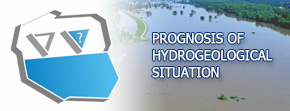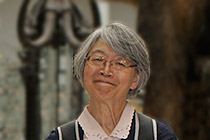 Within a period of eight months from its establishment, the Polish Geological Society Section of History of Geological Sciences organized a series of three successful meetings. The last was a Polish-Japan session devoted to pioneers who laid foundations for modern geology in Siberia and East Asia. Declarations of the Japanese delegation show that this joint session may be the start of cooperation between our researchers specializing in the history of our discipline.
Within a period of eight months from its establishment, the Polish Geological Society Section of History of Geological Sciences organized a series of three successful meetings. The last was a Polish-Japan session devoted to pioneers who laid foundations for modern geology in Siberia and East Asia. Declarations of the Japanese delegation show that this joint session may be the start of cooperation between our researchers specializing in the history of our discipline.
The Section of History of Geological Sciences, the youngest at the Polish Geological Society, is still receiving comments, suggestions and congratulations for its second session (20 April 2015) devoted to SE Poland as the cradle of the world’s petroleum industry thus, being a tribute to its Polish pioneers. In the meantime, the Section managed to organize its third session (18 September 2015) which may have even greater impact. The opportunity for organizing it was a visit of a four-person delegation of Japanese experts on the history of sciences. It was led by Dr. Michiko Yajima, chair of the Japanese Association for the History of Geosciences (JAHIGEO) and coordinator of the International Commission of the History of Geological Sciences at the International Union of Geological Sciences for Asia. Other delegation members included: paleobotanist Midori Matsumoto, top expert librarian Michiko Shintani and Takako Honjo, who specializes in the history of chemical sciences. An obvious choice was to organize a joint session devoted to pioneers who laid foundations for modern geology in Siberia and East Asia. It still remains valid for us and generations to come as excellent examples of researchers displaying a versatile approach and capability to conduct studies in boundless and practically pristine areas.
The session was very well organized by the Section in close cooperation with the Polish group at INHIGEO and with coordination by Prof. Stanisław Wołkowicz. In turn, the PGI-NRI took much care to provide appropriate catering and a technical setting for the event that attracted almost 40 members and supporters of the Section. Due to the of illness of Prof. S. Wołkowicz, the session was led by Prof. Marek Graniczny, who also moderated discussions.
The session began with a paper, “Naumann and Mt Fuji", compiled by Dr. Michiko Yajima on the basis of her joint presentation with Naotoshi Yamada from the Japan Geoscience Union Meeting in April 2014. It was a tribute to Edmund Naumann (1854-1927) and his role in laying foundations for modern geology in Japan with emphasis put on his fascination with Mt Fuji which proved to be a key to his successes in recognizing main features of the geological structure of Japanese islands. E. Naumann came to Japan from Saxony in 1875 when the Meiji government opened the door to Westerners and began to hire many foreign teachers and specialists. During this period known as the Meiji Era (1868-1912) Japan made a transition without parallel to a modern industrial state and world power. For his contribution to these changes E. Naumann was awarded the Order of the Rising Sun (Kyokujitsu-shō) and is widely recognized as the father of Japanese geology.
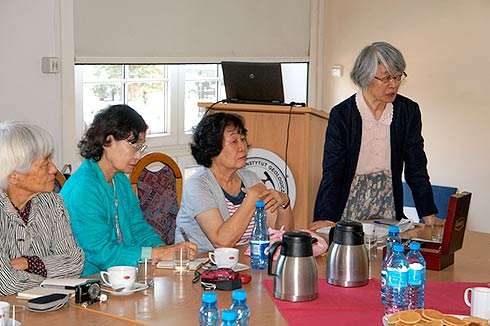
Dr. Michiko Yajima presented a history of the Geological Survey of Japan and the significance of initiated teaching of geology at the Kaisei Gakkō School, a predecessor of the Tokyo Imperial University. Left to right: Michiko Shintani, Takako Honjo, Midori Matsumoto, Michiko Yajima. Photo by K. Wołkowicz
During his stay in Japan in 1875-1885, E. Naumann lectured in geology at the Kaisei Gakkō School to be promoted to the post of first professor of geology when the school became an important part of the newly established Tokyo Imperial University. He was also an initiator and co-founder of the Geological Survey of Japan, which was established in 1882. From the moment of reaching Japan he became fascinated by Mt Fuji, an inspiration for artists and poets and object of pilgrimage for centuries and, as a result, a well-known symbol of Japan. This was the reason why his studies focused on attempts to identify major geological features of Japanese Islands and their connections to the origin and eruptions of the Mt Fuji volcano. These studies led to identification of the Fossa Magna tectonic rift, the Shizuoka Tectonic Line and the Outer and Inner Zone separated by the Median Tectonic Line (Chūō Kōzō Sen) together with compilation of the first geological reconnaissance map of Japan. His versatility is well shown by a libretto of the opera, Taketorimonogatari, which he wrote after returning to Germany. It was based on an old Japanese tale about a beautiful lady who came from heaven and back from Mt Fuji with the smoke of an eruption.
In the second part of the meeting, Prof. Marek Graniczny delivered a paper on the contribution of Polish geologists to studies on Siberia and East Asia compiled jointly with Krystyna Wołkowicz, Halina Urban and Stanisław Wołkowicz. The paper gave a concise overview of the outstanding achievements of more than a dozen researchers of Polish origin from a large group who studied vast and inaccessible areas of Siberia as far as Novaya Zemlya, Sakhalin Island, the Trans-Baikal region and the Commander (Komandorskie) Islands as well as Pamir, Afghanistan and Tibet until the end of World War I and even afterwards. These were deportees to Siberia (Aleksander Czekanowski, Jan Czerski), payroll or contract specialists working for the geological survey of Russia (Karol Bohdanowicz, Leonard Jaczewski, Józef Morozewicz, Stanisław Doktorowicz-Hrebnicki), Imperial Russian army officers (Colonel Leon Barszczewski and General Bronisław Grąbczewski) and researchers of Siberia at their own choice (Antoni Giedroyć, Kazimierz Grochowski). Special attention was paid to those who managed to return to the homeland when Poland regained its independence on November 11, 1918 after 123 years of partitions by Austria-Hungary, Germany, and Russia. This made it possible for them to use their profound experience by joining the process of restoring the domestic economy and training a new staff of geologists for the country strongly affected by the war and which suffered great losses. As emphasized by the authors, it is our duty to make the international community familiar with the contribution of Polish geologists to knowledge of world geology, especially in times when Poland disappeared from maps and Russian, Prussian or Austrian citizenship was forcibly imposed on anyone born in areas of the former Polish Kingdom. This is the task for completion of which no one will replace us.
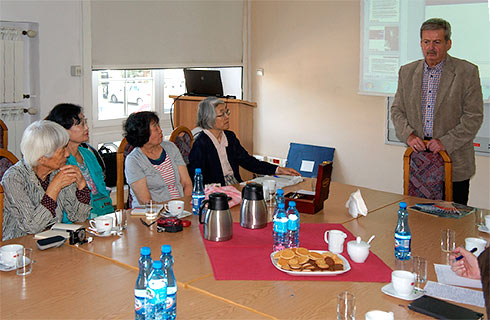
Prof. Marek Graniczny presents the contribution of Polish researchers in studies on the geology of Siberia and adjacent regions. Left to right: Michiko Shintani, Takako Honjo, Midori Matsumoto, Michiko Yajima and Prof. Marek Graniczny. Photo by K. Wołkowicz
The visit program also included a tour of the Geological Museum. Guests were guided by Ms. Marlena Świło with support of the former Under-Secretary of State and Chief National Geologist, Dr. Wojciech Brochwicz-Lewiński, throughout the entire Museum except for a temporary exhibition "Scraps from the past in brown coal” and a section devoted to the coal-bearing Carboniferous. Their role was swiftly taken over by Ms. Midori Matsumoto, who specializes in studies on coal-forming ecosystems..
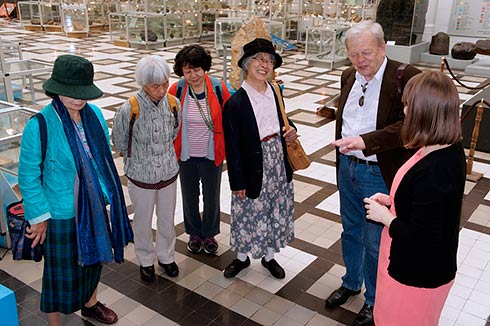
Tour of the PGI-NRI Geological Museum. Left to right: Takako Honjo, Michiko Shintani, Midori Matsumoto, Dr. Michiko Yajima, Dr. Wojciech Brochwicz-Lewiński and Marlena Świło. Photo by K. Wołkowicz
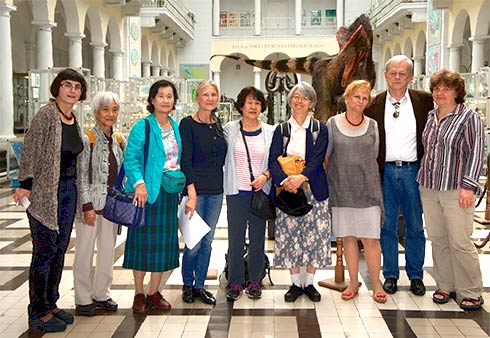
Commemorative "family” photo with a dinosaur called Dyzio. Left to right: Iwona Puźniak, Michiko Shintani, Takako Honjo, Dr. Urszula Hara, Midori Matsumoto, Dr. Michiko Yajima, Barbara Napieraj, Dr. Wojciech Brochwicz-Lewiński and Krystyna Wołkowicz. Photo by Prof. T. Peryt
The Guests also visited an exhibition of the oldest most precious geological maps and books from the PGI-NRI collection especially arranged for them by Library staff Joanna Kacprzak, Barbara Napieraj and Iwona Puźniak. This was an excellent opportunity to discuss plans for future cooperation over a cup of tea and Polish and Japanese snacks prepared by Ms. I. Puźniak, well familiar with Japanese tradition from her stay in Japan.
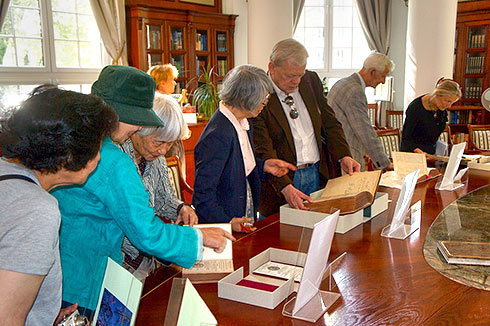
Fascination with the oldest and most precious prints (maps and books) from collections of the PGI-NRI. Left to right: Midori Matsumoto, Michiko Shintani, Takako Honjo, Dr. Michiko Yajima, Dr. Wojciech Brochwicz-Lewiński, Prof. Aleksander Guterch and Dr. Urszula Hara. Photo by K. Wołkowicz
In concluding remarks the Japanese delegation expressed deep hope that the Warsaw session will be the starting point for close cooperation between our researchers specializing in the history of our discipline and leading centers of geosciences. As emphasized by Dr. Michiko Yajima, marked interest in a presentation of Devonian amphibian footprints from the PGI-NRI collection at the Exhibition “Leaps in Evolution - Tracing the Path of Vertebrate Evolution” that opened last summer at the National Museum of Nature and Science in Tokyo is a very good sign for such cooperation.
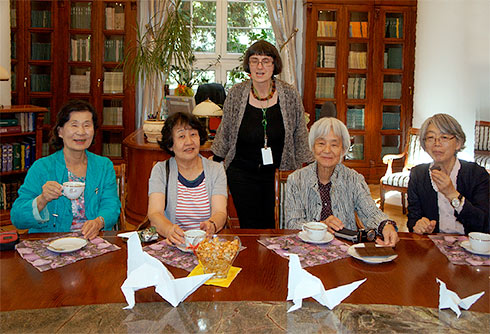
Discussions on future cooperation over a cup of tea and Polish and Japanese snacks arranged by Ms. I. Puźniak. Left to right: Takako Honjo, Midori Matsumoto, Iwona Puźniak, Michiko Shintani and Dr. Michiko Yajima. Photo by K. Wołkowicz
In closing remarks Prof. Marek Graniczny informed the audience that the next (fourth) meeting of the Section will be devoted to the 150th anniversary of the birth of Mr. Józef Morozewicz and his achievements, including the co-founding of the Polish Geological Institute in Warsaw and Mining Academy in Cracow in 1919. In a decision of the Section Board the date of this meeting is postponed to early December 2015 due to a unfortunate delay in publication of the J. Morozewicz commemorative book. This is a multi-author work edited by M. Graniczny, S. Wołkowicz, H. Urban and K. Wołkowicz.
The itinerary of the Japanese delegation also included meetings and sightseeing of Cracow as well as visits to the ancient Wieliczka salt mine and the Auschwitz-Birkenau Nazi death camp in the town of Oświęcim.
A final remark of Dr. Michiko Yajima should be noted that contacts between our communities of researchers should be greatly facilitated by a direct flight connection Warsaw – Tokyo starting from January 2016 . The B787 Dreamliner flights are to be operated by Polish Airlines LOT, so we should hope that this is not only just a dream…
Text: Wojciech Brochwicz-Lewiński and Krystyna Wołkowicz
Photos: Krystyna Wołkowicz and Tadeusz Peryt
Translation: Wojciech Brochwicz-Lewiński
PRESENTATIONS
pdf Edmund Naumann (1854‒1927) and Mount Fuji - Michiko Yajima and Naotoshi Yamada (2.07 MB)













 PGI-NRI offer
PGI-NRI offer Mineral resources of Poland
Mineral resources of Poland  Oil and Gas in Poland
Oil and Gas in Poland 




 Subscribe to RSS Feed
Subscribe to RSS Feed